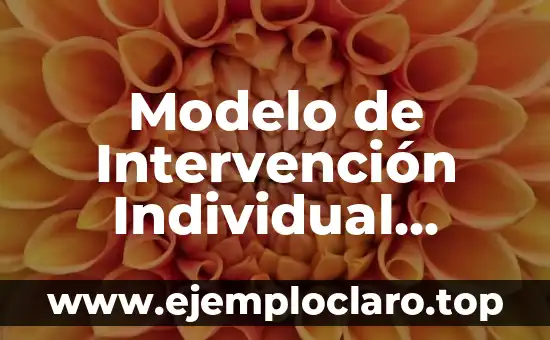El término modelo de intervención individual significado se refiere a un enfoque personalizado utilizado en diversas áreas como la psicología, la educación y el trabajo social. Este modelo se centra en adaptar las intervenciones a las necesidades únicas de cada individuo, asegurando que cada persona reciba el apoyo específico que requiere. A través de este enfoque, se busca promover el crecimiento personal y resolver problemas de manera efectiva.
¿Qué es un Modelo de Intervención Individual Significado?
Un modelo de intervención individual significado es un marco que tailores interventions to address the distinct needs of each individual. This approach recognizes that every person has unique circumstances, and thus, a one-size-fits-all strategy is often ineffective. By understanding the specific context, strengths, and challenges of an individual, professionals can design interventions that are more likely to succeed.
Historically, the shift towards individualized interventions gained momentum in the mid-20th century, particularly in education and psychology, as researchers began to emphasize the importance of personalization in learning and development.
La Importancia de las Intervenciones Personalizadas
Personalized interventions are crucial in various fields, including education, where they help cater to different learning styles, and in therapy, where they address specific mental health needs. These interventions have evolved over time, incorporating new techniques and technologies to enhance their effectiveness. For instance, the use of AI in education now allows for real-time adjustments to learning plans, ensuring each student’s needs are met as they progress.
También te puede interesar

El logotipo de Samsung es uno de los elementos más reconocidos de la marca, y detrás de su diseño hay una historia y un significado profundo. En este artículo, exploraremos detalladamente el significado del logotipo de Samsung, su evolución y...

El término finest se ha convertido en un tema de interés para muchos, especialmente aquellos que buscan comprender su significado más profundo. Aunque a simple vista parece referirse a algo excelente o de alta calidad, detrás de esta palabra hay...

En el mundo de la comunicación, entender cómo construimos significado colectivamente es esencial. Los modelos de la coencis significado nos ayudan a explorar este proceso, mostrando cómo creamos cohesión en nuestros mensajes.

El logotipo de la Organización de Cooperación de Shanghái (SCO) es un elemento fundamental en la identidad visual de esta entidad internacional. En este artículo, exploraremos detalladamente su significado, diseño y relevancia en el contexto global.

El término filático se refiere a la afición de coleccionar y estudiar sellos postales. Aunque el término más comúnmente utilizado es filatelia, filático comparte la misma raíz y significado, relacionado con este arte que combina historia, arte y cultura.

El logotipo de Sears, una de las empresas más reconocidas en el ámbito del retail y la venta al detalle, es un elemento fundamental de su identidad corporativa. Para entender su significado, es esencial sumergirse en la historia y evolución...
Ejemplos de Modelos de Intervención Individual
Several examples illustrate the application of this model:
- Education: Tailored learning plans for students with special needs.
- Therapy: Cognitive-behavioral therapy adapted to individual experiences.
- Healthcare: Personalized treatment plans based on genetic makeup.
- Social Work: Case management plans addressing specific family dynamics.
Each example involves a detailed assessment of the individual’s situation, followed by the implementation of targeted strategies.
Beneficios del Modelo de Intervención Individual
The benefits of this model are numerous:
– Effectiveness: Higher success rates due to targeted approaches.
– Efficiency: Resources are used more effectively, reducing waste.
– Engagement: Individuals are more likely to participate actively when interventions are relevant to their lives.
For example, in education, personalized learning has shown to improve student outcomes and reduce dropout rates.
Ventajas del Modelo de Intervención Individual Significado
The advantages include:
- Enhanced Engagement: Individuals are more invested in their progress.
- Improved Outcomes: Tailored strategies lead to better results.
- Efficiency: Resources are optimized, leading to cost-effectiveness.
- Flexibility: Interventions can be adjusted as needs evolve.
These advantages make the model a preferred choice in various sectors.
El Impacto de las Intervenciones Personalizadas
The impact of personalized interventions is profound, leading to improved outcomes across different areas. For example, in mental health, tailored approaches have been shown to reduce symptoms and improve quality of life. This effectiveness underscores the importance of adopting such models in various professional settings.
¿Para Qué Sirve un Modelo de Intervención Individual?
This model serves multiple purposes:
– Addressing Unique Needs: It provides targeted support to individuals.
– Promoting Growth: By focusing on strengths and challenges, it fosters personal development.
– Enhancing Efficiency: It ensures resources are used effectively, leading to better outcomes.
Examples include its application in education to support students with diverse learning needs and in therapy to address specific mental health issues.
Características del Modelo de Intervención Individual
Key characteristics include:
– Personalization: Interventions are tailored to the individual.
– Flexibility: Strategies can be adjusted based on feedback and progress.
– Comprehensive Assessment: Involves a thorough evaluation of the individual’s context.
These characteristics ensure that interventions are both effective and adaptable.
La Relación entre Intervención y Resultados
The relationship between intervention and outcomes is significant. Personalized approaches often lead to more favorable results, as they are designed to meet specific needs. This connection highlights the importance of adopting individualized models in professional practices.
El Significado de la Intervención Individual
The meaning of individual intervention lies in its focus on the unique aspects of each person. It emphasizes understanding and addressing specific needs, leading to more effective support and better outcomes. This approach is fundamental in various fields, ensuring that interventions are both meaningful and impactful.
¿Cuál es el Origen del Modelo de Intervención Individual?
The origins can be traced back to the mid-20th century when educators and psychologists began recognizing the limitations of standardized approaches. The shift towards personalization was further influenced by the development of new theories and technologies, particularly in the latter half of the century.
Variantes del Modelo de Intervención Individual
Variants include:
– Educational Interventions: Tailored learning plans.
– Therapeutic Interventions: Personalized treatment plans.
– Social Interventions: Case management plans addressing specific family dynamics.
Each variant adapts the core principles to fit the context and needs of the individual.
¿Cómo Aplicar un Modelo de Intervención Individual?
Application involves:
- Assessment: Evaluate the individual’s needs and context.
- Planning: Develop a tailored intervention strategy.
- Implementation: Execute the plan, incorporating feedback.
- Evaluation: Monitor progress and adjust as necessary.
This process ensures that interventions are both effective and responsive to the individual’s evolving needs.
Ejemplos de Uso del Modelo de Intervención Individual
Examples include:
– Education: A student with dyslexia receiving tailored reading support.
– Therapy: A patient with PTSD undergoing trauma-focused cognitive-behavioral therapy.
– Healthcare: A patient with diabetes on a personalized diet plan.
These examples illustrate the model’s versatility and effectiveness across different sectors.
INDICE

